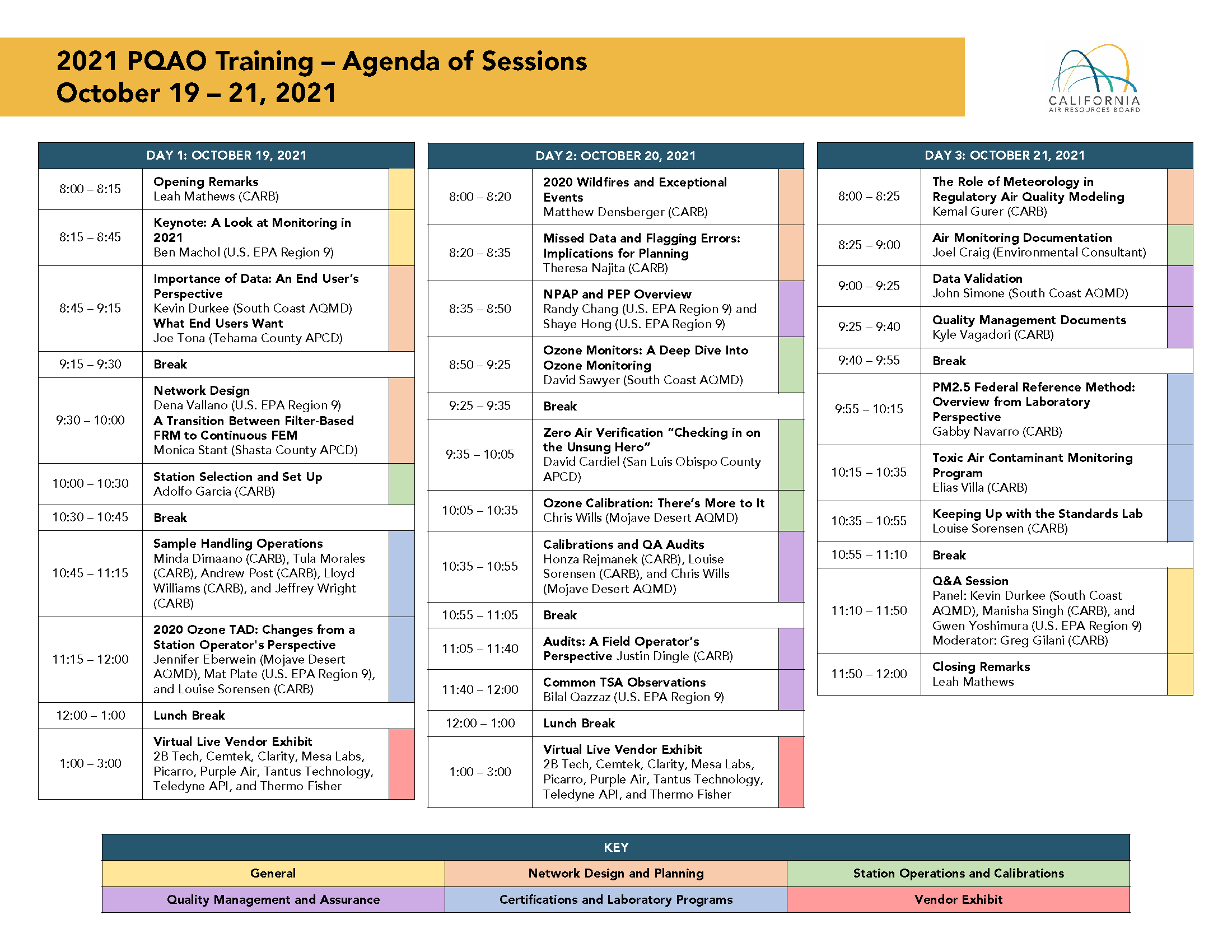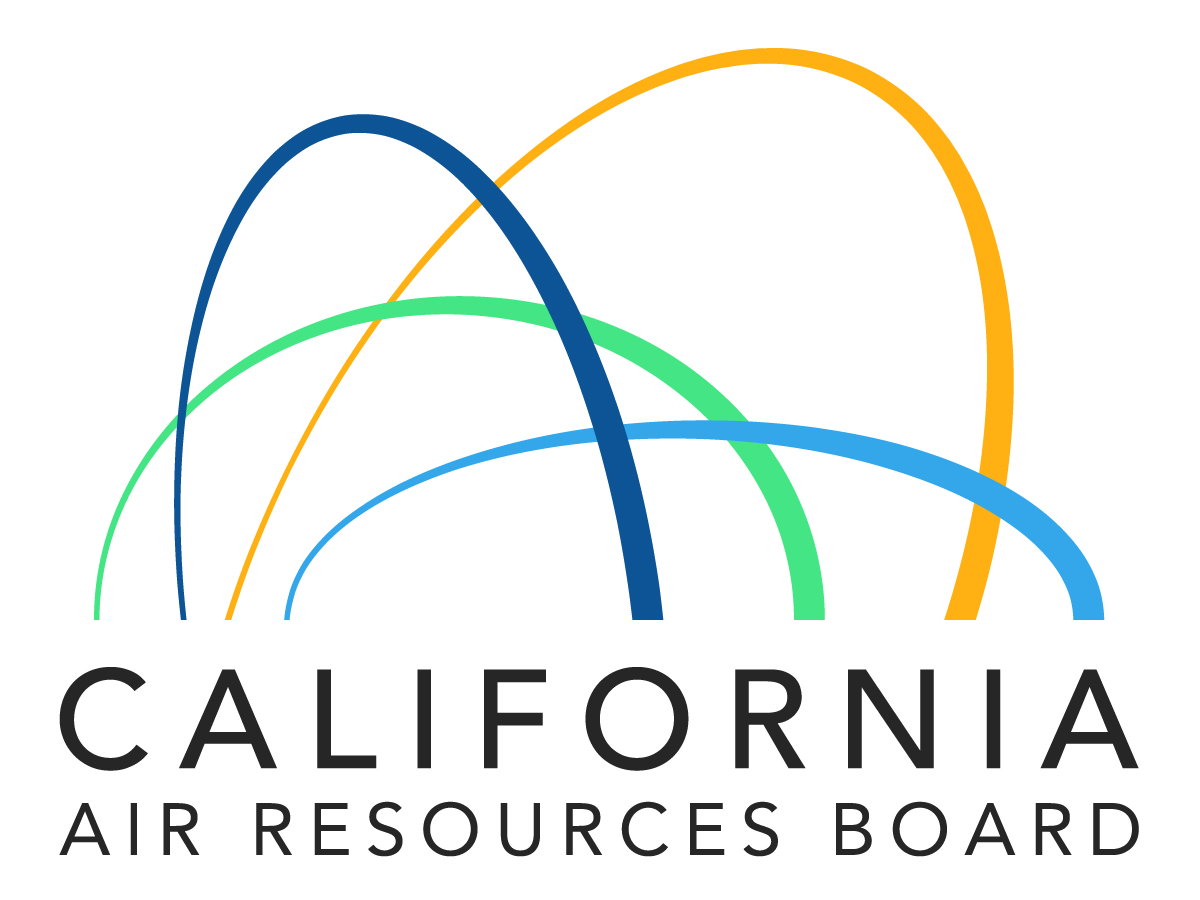2021 PQAO Training Agenda of Sessions
Presentations are listed below schedule in chronological order.

Tuesday, October 19, 2021
Opening Remarks
This session provides a brief introduction to the 2021 PQAO Training. Subjects include an introduction to the PQAO, event agenda, logistics, and an overview of the Pheedloop platform.
Leah Mathews (CARB)
Click here to watch this presentation
Keynote: A Look at Monitoring in 2021
A look at air quality trends and the unique challenges we face today.
Ben Machol (U.S. EPA)
Click here to watch this presentation
Importance of Data: An End User's Perspective; What End Users Want
Part 1 of this two-part presentation provides information on why our monitoring data is so important and how it is used. Objectives for air monitoring data and examples of how the data is used by various end users will be covered.
With the recent increase in extended wildfire smoke events, it is more important than ever that our data gets out to the public. In Part 2 of this presentation, Tehama County APCD covers the topic of “what users want”. Tools used to determine the types of data users are looking for, different methods of delivering data to the public, and the development of outreach materials are reviewed. Tehama County APCD also covers examples of what they have done based on their experience with wildfires that have burned throughout the region.
Kevin Durkee (South Coast AQMD) and Joe Tona (Tehama County APCD)
Click here to watch this presentation
Network Design; A Transition from Filter-based FRM to Continuous FEM
Part 1 of this two-part presentation provides an overview of federal regulatory requirements and considerations for designing an ambient air quality monitoring network. Topics include annual network plans, system modifications, and emerging challenges and innovations.
In Part 2 of this presentation, the primary operator for the Redding monitoring site of the Shasta County AQMD describes the process of transitioning from a filter-based FRM (a R&P Partisol 2000) to a continuous FEM (a BAM 1022) as the primary PM2.5 monitor for regulatory purposes. The presentation includes reasons for the change, installation and collocation, maintenance and data validation, how it helped with COVID-19 impacts, and lessons that may help other districts looking to make the same change.
Dena Vallano (U.S. EPA) and Monica Stant (Shasta County APCD)
Click here to watch this presentation
Station Selection and Set Up
This presentation gives an informative view on the factors and requirements when faced with the need to select and set up an air monitoring station. Considerations for site selection and equipment selection are also covered.
Adolfo Garcia (CARB)
Click here to watch this presentation
Sample Handling Operations
This presentation from CARB's sample handling team gives an overview of their sample handling operations, challenges, and outlook on the future. Responsibilities, common issues, and recent or anticipated changes are discussed.
Minda Dimaano (CARB), Tula Morales (CARB), Andrew Post (CARB), Lloyd Williams (CARB), and Jeffrey Wright (CARB)
Click here to watch this presentation
2020 Ozone TAD: Changes from a Station Operator’s Perspective
This is a presentation of the 2020 updates to the guidance document, "Transfer Standards for Calibration of Air Monitoring Analyzers for Ozone: Technical Assistance Document" followed by a discussion of the Mojave Desert AQMD's plan to implement changes necessary to comply with the expected requirements. Representatives from CARB and EPA will join Mojave AQMD and will be available for questions during the concluding Q&A of this session.
Jennifer Eberwein (Mojave Desert AQMD), Louise Sorensen (CARB), and Mathew Plate (U.S. EPA)
Click here to watch this presentation
Wednesday, October 20, 2021
2020 Wildfires and Exceptional Events
In this session, CARB discusses some of the air quality impacts seen in California from the extensive wildfires in 2020, as well as an overview of the exceptional events process.
Matthew Densberger (CARB)
Click here to watch this presentation
Missed Data and Flagging Errors: Implications for Planning
In this talk, CARB goes over various hypothetical scenarios to illustrate the implications on planning that can be caused by missed data and misapplied flags.
Theresa Najita (CARB)
Click here to watch this presentation
NPAP and PEP Overview
This session provides an overview of EPA's National Performance Evaluation Program for gaseous pollutants (CO, NO2, O3, SO2), PM2.5, and Pb. Topics include purpose of the program, audit requirements, and the environmental services assistance team (ESAT).
Randy Chang (U.S. EPA) and Shaye Hong (U.S. EPA)
Click here to watch this presentation
Ozone Monitors: A Deep Dive Into Ozone Monitoring
This presentation provides a comprehensive look at the maintenance and calibration of ozone monitors. Monitoring methods, theories of operation, instrument components, maintenance requirements, and instrument calibration traceability are among the many topics explored.
David Sawyer (South Coast AQMD)
Click here to watch this presentation
Zero Air Verification: Checking in on the Unsung Hero
An organization's procedure for zero air verification should be designed to test the purity and performance of its zero air generator for a particular station or lab. This session provides an overview of "Who, What, Where, When, Why, and How" of zero air verification.
David Cardiel (San Luis Obispo County APCD)
Click here to watch this presentation
Ozone Calibration: There's More to It
Ozone gas analyzers are the most prominent gas analyzers in our industry. This session is intended for all levels of audience experience and touches on the basics of ozone calibration and goes into a deeper dialogue on the steps involved.
Chris Wills (Mojave Desert AQMD)
Click here to watch this presentation
Calibrations and QA Audits
This three-part session covers 1) an overview of duties performed by the standards lab when you submit your calibration unit for certification, 2) an overview of gas analyzer calibrations, and 3) how an audit differs from a calibration and how to maximize your chance of passing an audit.
Honza Rejmanek (CARB), Louise Sorensen (CARB), and Chris Wills (Mojave Desert AQMD)
Click here to watch this presentation
Audits: A Field Operator’s Perspective
This presentation gives the perspective of a field operator during an audit, and covers how to best prepare for one. Siting issues, documentation and logs, data, and operation are discussed.
Justin Dingle (CARB)
Click here to watch this presentation
Common TSA Observations
In this presentation, EPA provides an overview of the common findings and recommendations EPA documents in their technical systems audit reports. It also touches upon one of the most effective practices to help minimize non-compliances with EPA regulations and guidance.
Bilal Qazzaz (U.S. EPA)
Click here to watch this presentation
Thursday, October 21, 2021
The Role of Meteorology in Regulatory Air Quality Modeling
This presentation gives an overview of the role meteorology plays in CARB's regulatory air quality modeling efforts. These efforts are carried out to keep California's air clean by keeping the concentration of air pollutants at or below the National Ambient Air Quality Standards (NAAQS) as part of the Clean Air Act (CAA).
Kemal Gurer (CARB)
Click here to watch this presentation
Air Monitoring Documentation
This presentation discusses various approaches to document station activities and covers options of different electronic document systems that monitoring organizations might consider implementing in their own monitoring networks.
Joel Craig (Environmental Consultant)
Click here to watch this presentation
Data Validation
This presentation covers an overview of data validation including the framework, sources for guidance, and levels of review. Validation templates from Appendix D of the EPA QA Handbook Vol II are also discussed.
John Simone (South Coast AQMD)
Click here to watch this presentation
Quality Management Documents
In this presentation, CARB describes what quality management documents are needed for PQAO air monitoring and why they are so important. Applicable references to use for the creation or adoption of documents, as well as CARB's document review process are described, including tips to keep it simple.
Kyle Vagadori (CARB)
Click here to watch this presentation
PM2.5 Federal Reference Method: Overview from Laboratory Perspective
This session gives a laboratory perspective on the requirements of PM2.5 FRM filter-based sampling. Focuses include laboratory criteria, sample validity, importance of field blanks and trip blanks, and common questions.
Gabby Navarro (CARB)
Click here to watch this presentation
Toxic Air Contaminant Monitoring Program
In this talk, CARB gives an overview of the Monitoring and Laboratory Division's Toxic Air Contaminant Monitoring program. History and network of the program, field and lab process overview, successes and challenges, and program future are discussed..
Elias Villa (CARB)
Click here to watch this presentation
Keeping up with the Standards Lab
CARB gives an update live from the standards lab. Milestones of the standards lab since the last PQAO Training in 2019 are covered.
Louise Sorensen (CARB)
Click here to watch this presentation
Q&A Session
This session is an opportunity to ask questions related to all air monitoring activities to a panel comprised of a representative from South Coast AQMD's Monitoring and Analysis Division, CARB's Quality Management Branch, and U.S. EPA's Air Quality Analysis Office.
Kevin Durkee (South Coast AQMD), Manisha Singh (CARB), and Gwen Yoshimura (U.S. EPA)
Click here to watch this presentation
Closing Remarks
Closeout and goodbye of the 2021 PQAO Training, including information on access to training content and what to expect post-completion of the PQAO Training.
Leah Mathews (CARB)
